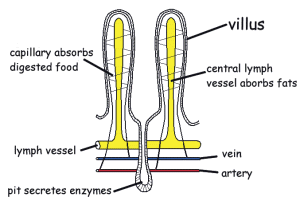A Journey Through The Alimentary Canal
Digestion is a complex process and a number of organs work together to complete the job. The Food passes through the alimentary canal which starts at the mouth and ends up at the anus. The alimentary canal is split into a number of sections which are adapted for a particular part of the digestive process.
To understand digestion we need to follow some food through the alimentary canal and find out what happens to it. We follow the journey of a chicken sandwich as it contains all the macro nutrients which will need to be digested.
Click on the diagram to jump to the relevant section.
A digram of the Digestive System

Mouth
Food is ingested and chewed. The teeth help to tear and grind the food into small pieces. This increases the surface area for the action of enzymes. The food is mixed with saliva which has two functions.
- The saliva contains mucus which is a slimy substance which helps the food to be swallowed.
- It contains the enzyme amylase which begins the digestion of starch into the sugar maltose. As food does not remain in the mouth for very long, only a small amount of starch is digested here.
The food is formed into an oval shape called a bolus by the tongue and soft palate before being pushed to the back of the mouth. A reflex action causes the food to be swallowed. Back to the top
Oesophagus
This muscular tube pushes the food to the stomach by way of rhythmic contractions. There are two sets of muscles in the oesophagus.
- Circular muscles - these make the oesophagus narrower.
- longitudinal muscles - these make the oesophagus wider.
They work inconjunction with each other to force the food down to the stomach. The circular muscle just behind the bolus contracts. This pushes the bolus forward. The longitudinal muscle infront of the bolus contracts making the oesophagus wider for the bolus to move into. When the bolus is moved forward the circular muscle just behind the bolus contracts while the longitudinal muscle relaxes. This continues in a rhythmic wave. This is the way food is move all way along the alimentary canal. It is called peristalsis. Back to the top
Stomach
When the food reaches the stomach gastric juice is released from the stomach lining. Gastric juice contains two substances.
- Pepsin - an enzyme which breaks proteins down into shorter chains called polypeptides.
- Hydrochloric acid - needed to help pepsin work and also helps to kill any ingested bacteria.
The stomach has two rings of muscles at the top and bottom, called sphincter muscles which prevent food from leaving the stomach while it is being churned around. After a few hours, the food is now a mushy liquid called chyme. It is then allowed to continue on its journey a bit at a time. Back to the top
Duodenum, Liver, Gall Bladder and Pancreas
When food enters the duodenum (the first 30cm of the small intestine) a number of secretions are added to it. Digestive enzymes from the wall of the duodenum and from the pancreas are added. There are a number of enzymes here which will complete the digestive process.
| Enzyme | Food Type Digested | Products |
|---|---|---|
| Amylase | Starch | Maltose |
| Maltase | Maltose | Glucose |
| Protease (eg trypsin) | Polypeptides | Amino acids |
| Lipase | Fats and oils | Fatty acids and glycerol |
Another substance is added from the gall bladder. Bile, made in the liver and stored in the gall bladder, contains no digestive enzymes. It contains bile salts (which are breakdown products of dead red blood cells) which play a vital role in fat digestion.
Fats and oils do not mix with water, but the enzyme lipase which digests them needs water in order to work. Bile salts breakdown the large fat drops into tiny droplets which can mix better with water to create an emulsion. This makes it easier for lipase digest the chemicals as it increases the surface area of the fat.
The pancreatic secretions contain hydrogen carbonate ions to neutralise the stomach acid. The enzymes of the small intestine work best in a slightly alkaline environment. Back to the top
Ileum
As food is digested the products are absorbed into the blood. There are a number of adaptations which increases the surface area for absorption. Without these adaptations digested food may not be absorbed before it is egested through the anus.
- The ileum is long and narrow which produces a larger surface area than a short broad tube.
- The ileum is folded which increases the surface area.
- The surface is covered with tiny (about 1mm long) fingerlike projections called villi.
- The cells on the surface of the villi have tiny fingerlike projections on
their cell membrane called micro-villi.

Colon
By the time the food reaches the large intestine all nutrients have been absorbed. What remains is indigestible fibre, bile salts and water. The water is absorbed here. The remaining substances (termed faeces) is passed along to the rectum before passing out through the anus. Back to the top
